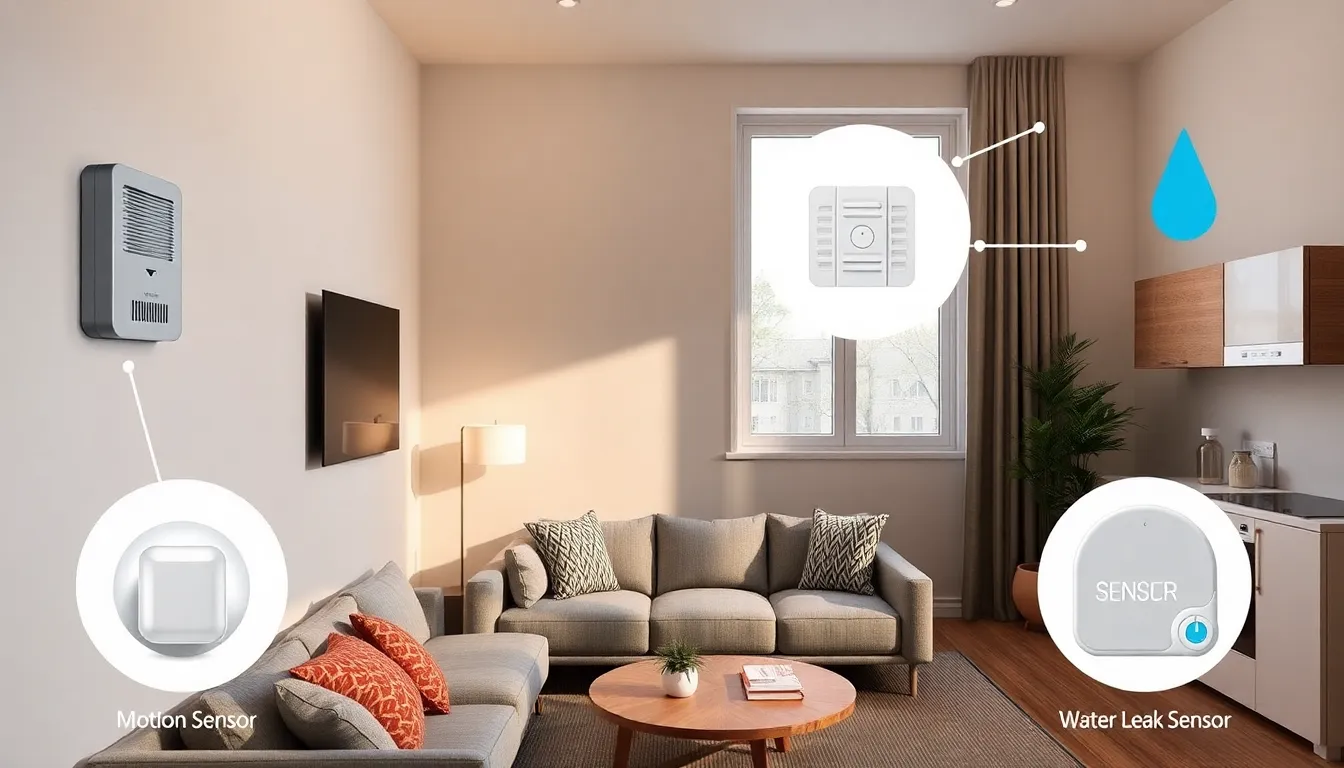Imagine walking into your home and having it greet you like an old friend—lights flick on, the thermostat adjusts, and your favorite playlist begins to play. Welcome to the world of smart home sensors, where technology meets convenience in a way that makes you wonder how you ever lived without them. These little gadgets are like the butlers of the future, tirelessly working behind the scenes to create a seamless living experience.
Smart home sensors aren’t just about impressing your friends at dinner parties. They offer real benefits—energy savings, enhanced security, and peace of mind. With a flick of a switch or a simple voice command, one can transform their home into a responsive, intelligent environment. So why not let your home do some of the heavy lifting? Dive into the fascinating realm of smart home sensors and discover how they can make life not just easier, but a whole lot more fun.
Table of Contents
ToggleOverview of Smart Home Sensors
Smart home sensors are devices designed to monitor various aspects of the home environment. These sensors enhance the functionality of smart home systems by providing real-time data about conditions like temperature, motion, light, humidity, and security status. They connect to a central hub, which interprets the data and communicates with other smart devices.
Temperature sensors adjust heating or cooling systems to optimize comfort and energy usage. Motion sensors detect occupancy, triggering actions such as lighting adjustments or security alerts. Light sensors automate lighting based on natural light availability, contributing to energy efficiency. Humidity sensors prevent mold growth by maintaining optimal moisture levels in the air.
Security sensors play a crucial role in home safety. Door and window sensors send notifications when potential intrusions occur. Cameras integrate with motion sensors, ensuring vigilant surveillance when movement is detected. Smoke and carbon monoxide detectors alert homeowners to hazards, significantly enhancing safety.
These sensors improve energy efficiency by facilitating automated control of appliances and systems. A thermostat can use data from temperature sensors to adjust its settings, which helps lower energy bills. Smart lighting adjusts based on occupancy, ensuring lights are only on when needed.
Automation further demonstrates the capabilities of smart home sensors. They can create schedules for devices, triggering actions based on set times or conditions. Integration with voice assistants allows simple voice commands to control multiple devices simultaneously.
Overall, smart home sensors contribute to a more responsive and efficient living environment. They streamline daily tasks, improve security, and promote energy conservation. With their growing presence in homes, these devices enhance modern living standards significantly.
Types of Smart Home Sensors
Smart home sensors come in various types, each serving unique functions to enhance efficiency and security in the home environment.
Motion Sensors
Motion sensors detect movement within a designated area. They activate lighting when someone enters a room, which fosters convenience and safety. Integration with security systems allows these sensors to send alerts if unexpected motion occurs during specific hours. Many models also offer customizable settings to reduce false alarms. When linked to smart assistants, they provide voice activation capabilities for seamless control.
Temperature Sensors
Temperature sensors monitor the indoor climate and help maintain comfortable conditions. They adjust heating and cooling systems automatically, ensuring energy efficiency. These sensors can connect to smart thermostats for real-time data sharing and optimization. Scheduled settings enable precise temperature control based on occupancy patterns. Some sensors alert users when temperatures reach critical levels, preventing potential damage to property.
Water Leak Sensors
Water leak sensors identify unwanted moisture in areas such as basements and near appliances. They alert homeowners immediately, minimizing potential water damage. Many systems feature a built-in shutoff valve that can stop water flow automatically when a leak is detected. Integration with smart home systems offers centralized monitoring and control. Users can customize alert settings to receive notifications on smartphones or other devices.
Benefits of Smart Home Sensors
Smart home sensors offer several advantages, enhancing daily life and promoting an efficient living environment. Their features provide significant improvements across various domains.
Enhanced Security
Enhanced security stands out as a primary benefit. Smart sensors monitor entry points, sending alerts when doors and windows are opened unexpectedly. Integration with cameras allows for real-time monitoring of activities outside the home. Intrusion detection systems can trigger alarms and notify homeowners immediately. These measures create a sense of safety, ensuring that families feel secure within their spaces. Violence prevention becomes more achievable as these sensors deter intruders effectively. Overall, peace of mind comes from knowing that your home is under constant observation.
Energy Efficiency
Energy efficiency represents another critical advantage. Smart sensors continually monitor energy consumption and optimize usage. Temperature sensors adjust heating and cooling based on occupancy, ensuring comfort without waste. These devices can create schedules for appliances, reducing electricity bills significantly. When combined with smart thermostats, energy savings become substantial throughout the year. Integrating light sensors provides additional benefits by automating lighting in response to natural light levels. Overall, these sensors contribute to reduced carbon footprints while enhancing household efficiency.
Convenience and Automation
Convenience and automation transform the daily routines of users. Smart sensors streamline tasks, enabling effortless control over various devices. Motion sensors activate lights automatically as someone enters a room, eliminating the need for manual switches. Water leak sensors promptly alert homeowners about potential damage, preventing costly repairs. Voice assistants connect with these sensors for hands-free operation, enabling seamless interaction. Home environments become effortlessly responsive, leading to improved quality of life. Overall, this automation promotes a hassle-free living experience that caters to individual preferences.
Considerations When Choosing Smart Home Sensors
Choosing smart home sensors involves several key factors to ensure optimal performance and compatibility.
Compatibility with Existing Systems
Assessing compatibility with existing systems is essential when selecting smart home sensors. A sensor that integrates smoothly with smart hubs, platforms, or devices enhances overall functionality. He or she should consider popular ecosystems like Amazon Alexa, Google Assistant, or Apple HomeKit. Reviewing specifications helps identify compatible devices. Some sensors provide better interoperability than others. Ensure the chosen sensors connect easily to existing Wi-Fi networks or Bluetooth devices for maximal efficiency. With a focus on seamless integration, users enjoy a more cohesive smart home experience.
Monitoring and Alerts
Selecting sensors with effective monitoring and alert capabilities is crucial for home security. Sensors that deliver real-time alerts via mobile apps or smart assistants enhance user responsiveness. Users should prioritize sensors that provide custom notification settings based on their preferences. Different types of sensors, such as motion detectors or smoke alarms, should offer immediate alerts. Users appreciate remote monitoring features that allow them to check home conditions while away. Evaluating the response time of alerts ensures that the system effectively addresses potential issues promptly. Thus, investing in smart sensors with robust monitoring capabilities creates a safer, more efficient living environment.
Conclusion
Smart home sensors represent a significant advancement in home technology. By integrating these devices into daily life, homeowners can enjoy enhanced security and energy efficiency. The ability to automate and monitor various aspects of the home environment not only provides peace of mind but also fosters a more responsive living space.
As technology continues to evolve, the potential for smart home sensors will only expand. With the right choices and proper integration, individuals can transform their homes into intelligent ecosystems that cater to their unique needs. Embracing this technology is a step toward a more convenient and secure future.







